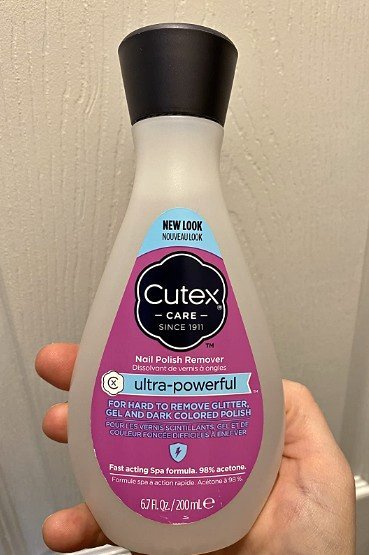Nail polishes contain ingredients such as resins, plasticizers, film molds, and color pigments. All of these ingredients work together to give a beautiful coat that dries evenly.
For you to be changing your nail color often, you need quality nail polish but you also need a good nail polish remover.
It is important to use a nail polish remover that is effective and works with your type of nail. The nature of your polish remover determines the appearance and health of your nail.
Here are two types of nail polish remover available: acetone and non-acetone nail polish remover.
What is an Acetone Nail Polish Remover?

An acetone nail polish remover is a very strong solvent that removes nail polish harshly. The major component is acetone.
Acetone is a strong-smelling, highly flammable liquid capable of melting plastics which is why it works very quickly to break apart and remove nail polish.
It extracts a lot of oil from the nail and skin, dehydrating and damaging your nail plate significantly.
What is a Non-acetone Nail Polish Remover?

A non-acetone nail polish remover is completely devoid of acetone. It uses less harmful solvents and also contains moisturizing agents such as glycerin to minimize the dry out.
Differences Between Acetone and Non-acetone Nail Polish Remover
With these different types of nail polish removers in the market, I’ve selected a few aspects of both to compare to help you decide on the best one to use.
1. Composition
An acetone nail polish remover has a major constituent of diluted acetone. Acetone in its pure form is harsh, has a pungent smell, is highly flammable, and is strong enough to melt the plastic.
Acetone-based nail polish remover works by dissolving the nail enamel and removing it either by using a cotton pad or soaking.
During the process of removal, there might be some rubbing of the inner layers of the nail, damaging the nail plate.
On the other hand, a non-acetone nail polish remover is made with milder solvents such as ethyl acetate, butyl acetate, and petroleum.
These solvents are milder on the skin and nails, greatly reducing the damage risk.
2. Effectiveness
Being so strong and harsh, acetone nail polish removers clean off the nail polish fast. They can also penetrate nail extensions, breaking them down for easy removal.
Non-acetone nail polish remover is not as effective as its counterpart. Because it is gentler, you’ll take more time rubbing and soaking to be able to get the nail polish off.
3. Impact on Nails
Even though acetone-based nail polish removers work fast when cleaning off nail polish, they dehydrate the nails and cuticles.
With prolonged and repeated use, the nails and cuticles are slowly bleached white and the nails become brittle and prone to breakage.
There might be itching and redness in the skin surrounding the nails, which might slowly aggravate other skin conditions and diseases.
Non-acetone nail polish removers have a milder formula and are produced containing glycerin, panthenol, and soya which have moisturizing effects.
So, they strip off the old polish, while moisturizing the cuticles and nails. This mutes the harm that might occur during usage.
4. Suitability
Acetone Nail polish removers are more suitable for glitter or shellac manicure removal. In general, they work better for acrylic and gel manicures.
Non-acetone nail polish removers are better situated for the removal of regular nail polish. Although they are still effective for other types of manicures, they are just not as effective.
The bigger advantage of non-acetone nail polish remover is that there won’t be any yellowing when you use them on your nails. It is also suitable for all kinds of skin with varying degrees of sensitivity.
In a nutshell, both types of nail polish removers have their pros and cons. You should make your choice based on your need.
If you’re going for speed, you’re free to use an acetone nail polish remover. If you don’t mind the time it will take and prefer to have healthier nails for the long run, you can try non-acetone nail polish remover.
FAQs on Acetone Vs Non-acetone Nail Polish Remover
What kind of nail polish remover is best?
Despite the idea that non-acetone nail polish remover is healthier for the nails, acetone nail polish remover is still a strong contender because its ability to work in a shorter time means less time spent exposed to chemicals.
What are the benefits of non-acetone nail polish remover?
It doesn’t dry out the skin as acetone-based nail polish remover does. Non-acetone remover has oils, so it leaves the nails feeling nourished and healthy.
What is the least damaging way to remove nail polish?
Acetone and non-acetone nail polish removers still have the gold badge for being the best option for removing nail polish. They are considered safe to use in small amounts.
Which nail polish remover is preferred when prepping nails?
Acetone nail polish is preferred when prepping nails because it completely removes the natural oils from the nails which are needed at this stage. Non-acetone removers won’t dry out the nails as much.
